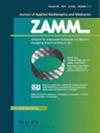Thermally stratified Cu–Al2O3/water hybrid nanofluid flow with the impact of an inclined magnetic field, viscous dissipation and heat source/sink across a vertically stretching cylinder
IF 3.2
4区 工程技术
Q1 MATHEMATICS, APPLIED
Zamm-zeitschrift Fur Angewandte Mathematik Und Mechanik
Pub Date : 2023-09-22
DOI:10.1002/zamm.202300084
引用次数: 0
Abstract
Abstract A numerical study of the thermally stratified flow of H 2 O based Cu − Al 2 O 3 hybrid nanofluid over a linearly stretching cylinder placed vertically in a porous media has been performed. The influences of viscous dissipation, thermal source/sink, and an inclined magnetic field were also considered. Using appropriate similarity transformations, the non‐linear mathematical equations of the flow model are translated into a dimensionless form. The in‐build finite difference Matlab code Bvp4c is used to attain the numerical solution of the transformed non‐linear ordinary differential equations (ODEs). Influences of nanoparticles when added to the water and also the flow parameters’ impacts on the flow rate and thermal transport rate are shown in graphs and tables. The results showed that the absolute value of the shear stress of the hybrid nanofluids was enhanced by up to 33% compared to the considered nanofluid. The study also revealed that the heat transport rate in the convective flow region was much higher in hybrid nanofluid as compared to nanofluid. For Cu − Al 2 O 3 /water hybrid nanofluid, the temperature went negative for high thermal stratification. The present study has important implications for the design and optimization of heat transfer devices that use thermally stratified hybrid nanofluids. The results also provide novel insights into the flow behavior of these fluids, that can be used to improve our understanding of their physical properties.热分层Cu-Al2O3 /水混合纳米流体在倾斜磁场、粘性耗散和热源/汇的影响下在垂直拉伸圆柱体上流动
摘要采用数值方法研究了基于h2o的Cu - Al - 2o3杂化纳米流体在垂直放置于多孔介质中的线性拉伸圆柱体上的热分层流动。同时考虑了粘性耗散、热源/汇和倾斜磁场的影响。利用适当的相似变换,将流动模型的非线性数学方程转化为无因次形式。利用内置的有限差分Matlab代码Bvp4c对变换后的非线性常微分方程(ode)进行数值求解。以图形和表格的形式显示了纳米颗粒加入水中的影响以及流动参数对流速和热输运率的影响。结果表明,混合纳米流体的剪切应力绝对值比考虑的纳米流体提高了33%。研究还发现,与纳米流体相比,混合纳米流体对流区的传热速率要高得多。对于Cu−al2o3 /水混合纳米流体,温度为负,热分层高。本研究对采用热分层混合纳米流体的传热装置的设计和优化具有重要意义。该结果还为这些流体的流动行为提供了新的见解,可用于提高我们对其物理性质的理解。
本文章由计算机程序翻译,如有差异,请以英文原文为准。
求助全文
约1分钟内获得全文
求助全文
来源期刊
CiteScore
3.30
自引率
8.70%
发文量
199
审稿时长
3.0 months
期刊介绍:
ZAMM is one of the oldest journals in the field of applied mathematics and mechanics and is read by scientists all over the world. The aim and scope of ZAMM is the publication of new results and review articles and information on applied mathematics (mainly numerical mathematics and various applications of analysis, in particular numerical aspects of differential and integral equations), on the entire field of theoretical and applied mechanics (solid mechanics, fluid mechanics, thermodynamics). ZAMM is also open to essential contributions on mathematics in industrial applications.

 求助内容:
求助内容: 应助结果提醒方式:
应助结果提醒方式:


